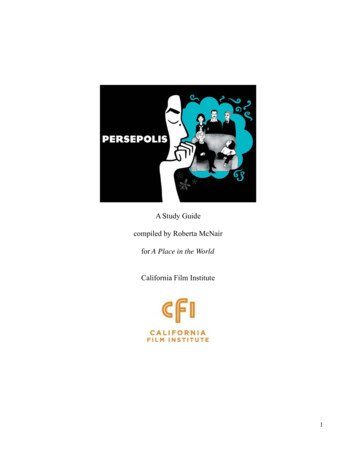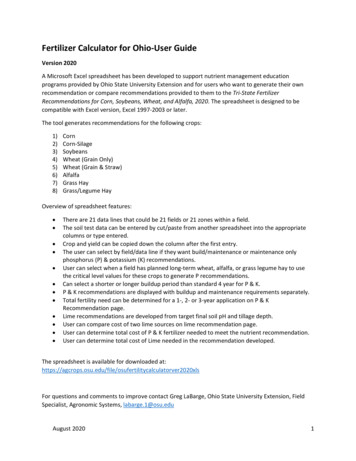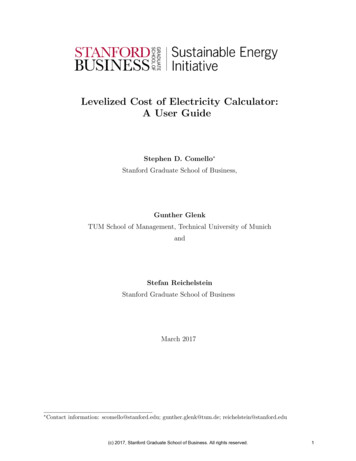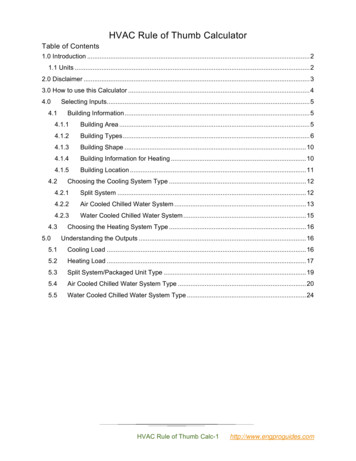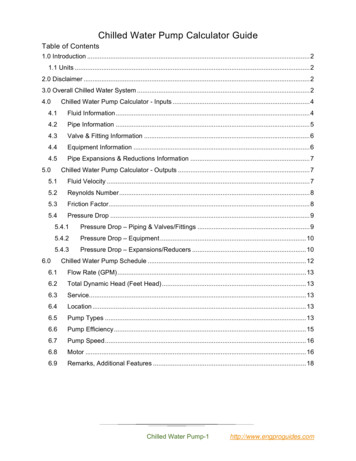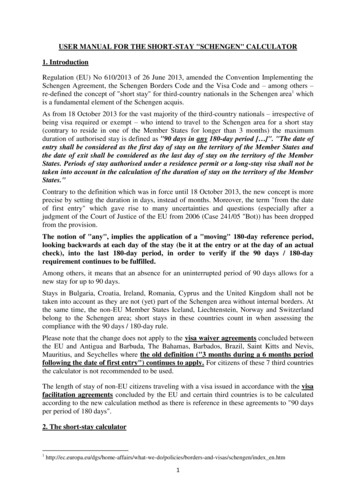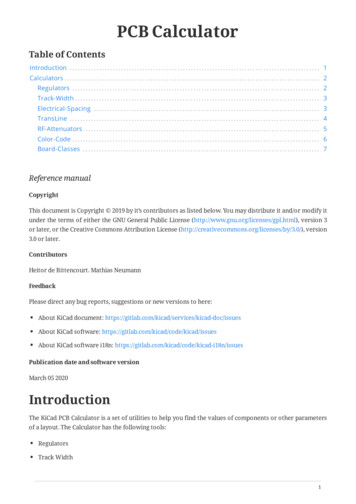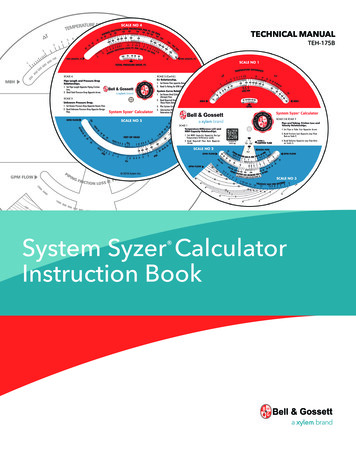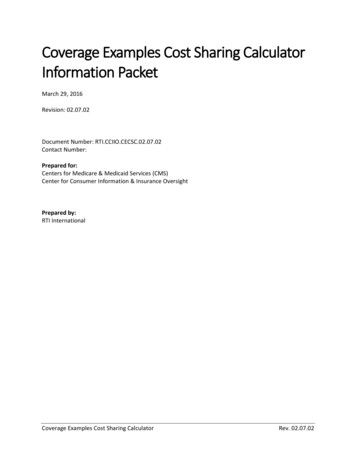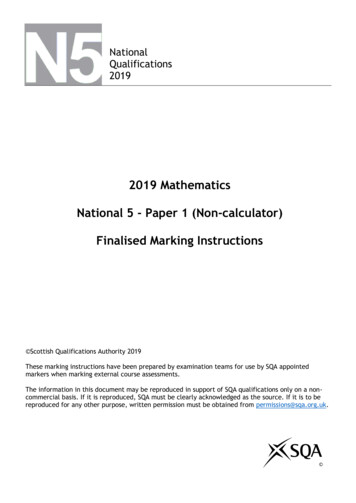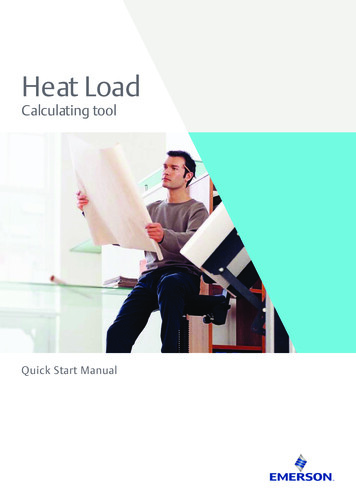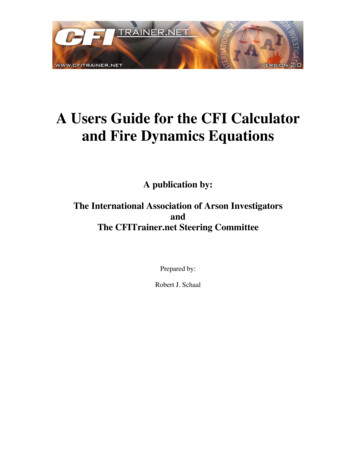
Transcription
A Users Guide for the CFI Calculatorand Fire Dynamics EquationsA publication by:The International Association of Arson InvestigatorsandThe CFITrainer.net Steering CommitteePrepared by:Robert J. Schaal
DisclaimerThe International Association of Arson Investigators (IAAI), CFITrainer.net andStonehouse Media make no warranty, expressed or implied, to users of the CFICalculator and the CFI Calculator Users Guide and accepts no responsibility for its use.Users of CFI Calculator and the CFI Calculator Users Guide assume sole responsibilityfor determining the appropriateness of its use in any particular application; for anyconclusions drawn from the results of its use; and for any actions taken or not taken as aresult of analysis performed using this tool.Users are warned that CFI Calculator and the CFI Calculator Users Guide is intended foruse only by those competent in the field heat transfer, combustion and fire science, and isintended only to supplement the informed judgment of the qualified user. This calculatormay or may not have predictive capability when applied to a specific set of factualcircumstances. All results should be evaluated by an informed user.This document has undergone extensive review but no warranty against errors oromissions is expressed or implied.The IAAI would like to thank the following individuals for their review and contributionsto this document:Special Agent Robert J. Schaal, ATF – Principal WriterDr. James Quintiere – Technical Review and EditingSpecial Agent Daniel Heenan, ATF – Technical Review and EditingSpecial Agent Steven Avato, ATF – Technical Review and EditingSpecial Agent Steven Carman, ATF – Technical Review and EditingLiz Connolly, Stonehouse Media – Project Development and CoordinationIan Scott, Stonehouse Media- DeveloperJason Jammer, Stonehouse Media- Art DirectorJon Jones, Jones and Associates – Project Development and Coordination2Copyright www.CFITrainer.net, 2005-2008.
Table of ContentsIntroduction Page 4Downloading .Page 5User Interface .Page 6Equations Page 7Heat Release Rate .Page 8Flame Height .Page 14Heat Flux .Page 25Time to Ignition Page 33Flashover .Page 37Fire Growth .Page 48Sprinkler Activation .Page 53End Notes Page 593Copyright www.CFITrainer.net, 2005-2008.
INTRODUCTION:The CFITrainer.net CFI Calculator was developed as a part of a grant received bythe International Association of Arson Investigators through the Federal EmergencyManagement Agency, Assistance to Firefighters Grant Program. The calculator isdesigned to assist field fire investigators in the development and testing of hypothesiswhile utilizing the scientific method, and to provide the investigator a tool that can beutilized to analyze fire behavior using fire dynamics equations.The various formulae contained in the CFI calculator tool were derived fromexisting scientific publications and literature and have been subjected to continuedassessment and peer review. The calculator is currently published in three formats,including a Palm OS application, a Pocket PC application and a desktop PC application.While the look and feel of the three versions may differ slightly as a result ofoperating systems functionality and screen real estate issues, the calculated results areconsistent. The tool has undergone extensive testing to ensure that the calculated resultsare consistent with calculated results derived utilizing alternative methods including longhand equation solving, solving utilizing programmable scientific calculators and solvingutilizing other computer based tools.The calculator currently contains seven equations including Flame Height, HeatFlux, Flashover, Fire Growth, Sprinkler Activation, Heat Release Rate and Time toIgnition. A number of these equations contain radio buttons, which are utilized toincrease the functionality of the equation, allowing the user to solve for differentunknown variables. Additionally, the tool employs drop down menus in a number ofequations to serve as a reference guide for commonly utilized values.4Copyright www.CFITrainer.net, 2005-2008.
While the equations stand alone in analyzing specific aspects of fire growth andbehavior, there is an interrelationship between a number of the equations such as HeatRelease Rate and Flame Height or Heat Release Rate and Heat Flux, etc. This allows theequations to be utilized in conjunction with one another to analyze multiple aspects of agiven scenario. While these equations can be very useful in hypothesis development andtesting, it is important to recognize that these formulas do have limitations and areappropriately utilized to bound a problem, defining a “fence” around the realm ofpossibilities. These equations may provide support to a hypothesis or show that aparticular hypothesis is less likely than others. However, no single formula or data willtypically prove that an event could not have occurred; only that is was less likely giventhe parameters. For example, in estimating a time to Flashover the investigator maycalculate a range of values from 1 to 4 minutes (depending on input). This should not betaken as proof that Flashover could not have occurred at 5 minutes, only that Flashoverwas feasible as soon as 1 to 4 minutes. This tool is designed to be utilized by thoseindividuals that have a sound knowledge of fire dynamics and fire dynamics equationsand the use of this tool may require referencing additional scientific literature orconsulting outside experts.DOWNLOADING:The CFI Calculator is available for download to registered CFITrainer.net users atwww.cfitrainer.net. All three versions (Palm, Pocket PC and Desktop) are available onthis website and users are free to choose any or all of the applications. The desktop andPocket PC versions require the installation of a .Net Framework version 2.0 applicationand directions for locating the download are available on the CFITrainer.net site.5Copyright www.CFITrainer.net, 2005-2008.
Installation of updated versions may require the removal of older versions. Technicalsupport is available if users have problems installing or running the applications.Additionally, the site hosts a frequently asked questions forum that addresses many of thecommon questions a user may have without the need for additional technical support.Users are also encouraged to provide feedback to the development team to ensure that theproduct is serving the needs of the fire investigation community, identify potential bugsthat need correction, and provide insight on how the tool should be improved in futurereleases.USER INTERFACE:The application is typically launched by pressing a screen icon, similar to othercomputer applications. Upon opening, the home screen will appear, listing the variousequations contained in the calculator tool. The equations are listed on “buttons” that areutilized to launch each specific equation tool. Additionally, a link to the generaldisclaimer is available on the home screen, warning users of the limitations of the tool.Once a button is clicked, the selected calculation will open and an input screen willappear allowing the input of the required variables necessary for solving the particularequation. The screen also includes a help button that opens additional informationconcerning the application of a particular formula and contains limited reference material.Additional navigation tools are available including a “Home” button that takes the userback to the opening screen containing all of the equations and a calculate button that willsolve the equation and take the user to the output screen. The Pocket PC and Desktopversion also contain a numeric and/or graphic input tool, which can be utilized forinputting the necessary data without the use of an external keyboard. As previously6Copyright www.CFITrainer.net, 2005-2008.
mentioned, a number of applications contain drop down menus, allowing the input ofcommon values without the need of additional reference materials. In a number ofapplications, these drop down menus can be toggled on and off by depressing a button,allowing the user to manually input specific data, if available. Once transitioning to theoutput screen, the user will view the calculated results and additionally have a “Back”button navigation tool that returns the program to the input screen of the specificequation, allowing the user to run multiple iterations of the equation without difficulty.The program does not store or recall results so it is imperative that the user record theinput variables and the output measures for later use.EQUATIONS:The next several sections relate to the various equations included in the CFICalculator tool and are designed to break each formula down so the user understandswhat the requested input means, where to find the input data, and what the outputmeasurements signify. By providing the user a better fundamental understanding of theequations, it is believed that the user will become better informed and better able to applythe tool to their fire scene hypotheses. The formulas and the CFI Calculator tool aredesigned to assist the field investigator in the analysis of fire behavior at fire event,analyze witness statements versus expected fire behavior, and predict results whenconducting tests and experimentation. The formulas and the CFI Calculator tool areintended to be utilized as a part of and in furtherance of the proper application of theScientific Method to a fire scene investigation. As some applications utilize more thanone formula in calculating output data, each formula utilized will be discussed in theappropriate section to which it relates. The equations will not necessarily be discussed in7Copyright www.CFITrainer.net, 2005-2008.
the order in which they appear on the CFI Calculator tool. It is important to note thatall equations require input in metric values and conversions should be done prior toutilizing this tool.The most common measurements that need to be converted are feet to meters andoFahrenheit to oCelsius. Simple formulas for these conversions are:meters feet / 3.2808 and Celsius ( Fahrenheit 32) / 1.8HEAT RELEASE RATE:One of the fundamental properties of a fuel is its Heat Release Rate or Fire Power,which represents how much energy an item gives off over a period of time. It isrepresented by the symbol Q& , and is most accurately defined as “the energy produced bythe fire per unit time or fire power.”1 It takes into account a fuel’s effective heat ofcombustion (energy released by the fire per unit mass of burned fuels)2, the mass loss rateper unit area (the mass of the fuel vaporized but not necessarily burned)3, and the burningarea.The formula for determining the heat release rate or energy release rate4 of a give fuel is:Q& m& ′′A ΔH cWhere:Q& Heat Release Rate in Kilowatts (kW)m& ′′ Mass Loss Rate of a given fuel in grams per unit area per second( g m 2 s ). This value relates to how much “weight” a fuel loses over a giventime (in seconds) and is usually a value derived from scientific reference material.8Copyright www.CFITrainer.net, 2005-2008.
A the area involved in the vaporization measured in square meters. (Note:When calculating the area of a pool fire, utilize the equation A π4D 2 , where D the diameter of the pool.)ΔH c the effective heat of combustion measured in kilojoules per g ( kJ g ).This value is usually derived from scientific reference material.Utilizing this equation to calculate the estimated heat release rate of a pool fire ofgasoline measuring approximately 1 meter across, with a Heat of Combustion ( Δ Hc )value of 43.7 kJ g and a Mass Loss Rate ( m& ′′ ) value of 55 g m 2 s (Average of range 50-60 g m 2 s ), the area of the fuel would first be calculated as follows:A π4D2 π4(1 m) 2 0.785 m 2The Heat Release Rate equation would then be utilized by inserting the data in theappropriate fields and the following results would be expected:Q& (55 g / m2 s)(0.785 m2 ) (43.7 kJ / g )Q& 1887 kWThe expected input screen and output screen utilizing the CFI Calculator tool withthe same values discussed previously are demonstrated below:9Copyright www.CFITrainer.net, 2005-2008.
The tool is designed to allow the user to utilize the materials drop down menu (inthis example we would select gasoline, and the stored data for the mass loss rate andeffective heat of combustion would be utilized in the calculation. References for thevalues utilized in the drop down menu are also contained in the help file) or exactvariables can be entered, if known to the user. When determining the area involved invaporization, it is calculated by multiplying the length in meters by the width in meters.The area of a pool fire is calculated based on it’s diameter in meters. For irregular shapedobjects or irregular shaped pools, some approximations or estimates might have to beutilized. This calculator application has a radio button that allows the user to select ifthey are calculating the Heat Release Rate of a pool or a standard item. Examples of thedrop down menu and reference help file are illustrated below:10Copyright www.CFITrainer.net, 2005-2008.
An additional check with an Excel Spreadsheet tool (based on a spreadsheet tooldeveloped by Dr. Fred Mowrer5, with minor modifications) would yield the followingoutput results:Q dot Heat Release RateInput ParametersHeat of Combustion (ΔHc)43.7Mass Loss ( m& ′′ )55Area of Fuel Surface (A)0.785Calculated ParametersHeat Release Rate ( Q& )1886.7kJs/m2kgs/m2m2kWThese examples demonstrate that the calculated results are consistent with themanual calculation, the CFI Calculator Tool and the Excel Spreadsheet. Additionalvalidation can be done by comparing the calculated/estimated results with data derived asa result of laboratory experimentation.11Copyright www.CFITrainer.net, 2005-2008.
In 2005, an experiment involving a gasoline pool fire was conducted at theBureau of Alcohol, Tobacco, Firearms and Explosives, Fire Research Laboratory as apart of a training session conducted for the International Association of ArsonInvestigators 56th Annual Training Conference. The experiment involved burningapproximately 3.79 liters (1 gallon) of gasoline in a pan measuring approximately 0.55meters (22 inches) in diameter. The pan was placed on a load cell to calculate the massloss rate and the burn was conducted under a cone calorimeter to allow for themeasurement of both peak heat release rate and total heat release rate. Thermocoupleswere set above the pool in 0.30 meter (1 foot) increments and heat flux gauges were setup approximately 0.50 meters and 1 meter from the axis of the pan.With the given parameters of the experiment, the fuel properties and pandimension can be utilized to calculate the estimated heat release rate. With the givenvalues, the calculated peak heat release rate would yield the following results:Area of Pool:A π4D2 π4(0.55 m) 2 π4(.303 m 2 ) 0.238 m 2Heat Release Rate:Q& (55 g / m 2 s)(0.238m 2 ) (43.7 kJ / g )Q& 572 kW12Copyright www.CFITrainer.net, 2005-2008.
The estimated peak heat release rate of the fire defined in these experiments is572 kW. The experiment was run two times under the same set up parameters with theresults listed below:Peak(kW)30 secondmaximumaverage (kW)1 minutemaximumaverage (kW)5 minutemaximumaverage (kW)Total heatreleased (kJ)3264913064572994422663099460796949As is demonstrated in this experiment, the measured results of actual peak heatrelease rate in the two experiments (326 kW and 491 kW respectively) utilizing the sameparameters, fall below the calculated results of 572 kW. Utilizing the range of mass lossrate published for gasoline (50-60 g m 2 s ) the peak heat release rate can be calculatedat somewhere between 518 kW and 622 kW for the parameters defined in the experiment.These results are closer to the observed measurements at the lower end, and certainlyhelp illustrate that these equations are appropriately utilized to bound a problem butcannot be expected to yield exact results. The number of variables that can influenceexperimental results including heat loss to the pan and heat loss to the floor are often toodifficult to factor into equations and, therefore, experimentally derived results will varynot only from test to test but, often from the calculated results as well. These differencesnot withstanding, utilized appropriately, fire dynamics equations and calculations canserve an important role in the analysis of fire events.The Heat Release Rate measurement is a common input value throughout most ofthe equations utilized in the CFI Calculator tool. In particular, it is closely associatedwith the flame height and heat flux calculations, as these properties are a function of, or13Copyright www.CFITrainer.net, 2005-2008.
greatly influenced by Heat Release Rate. While the Heat Release Rate equation can beutilized on it’s own to help quantify the amount of energy a particular fuel or item willrelease, these other equations can also be utilized to help the investigator estimate thisproperty of a burning item. The alternative uses of additional formulas will be discussedin the appropriate section.FLAME HEIGHTFlame height is closely associated with the amount of energy being released by afuel (Heat Release Rate or Q& ) with fuels with higher energy release rates expected tohave higher flame heights as compared to those with lower heat release rates. Otherfactors, such as fuel configuration and fuel location, can also influence flame height andshould be considered when utilizing these formulae. There are a number of calculationsthat have been developed that can be utilized to estimate the flame height based on theheat release rate and conversely, estimate the heat release rate based on an observedflame height. These formulas are useful in predictive analysis while conducting firetesting as well as analyzing witness statements. When calculating flame height, themeasurement is taken from the base of the flame to the height above the flaming object,not from the base of the object.14Copyright www.CFITrainer.net, 2005-2008.
Flame Height CalculationsFlame height measuredfrom base of flamelf lflfThe first formula to be discussed was developed by McCaffrey6 and is expressedas follows:Z c 0.08 Q& 2 / 5andZ i 0.20 Q& 2 / 5Where:Zc Consistent Height of Flame in MetersZi Intermittent Height of Flame in Meters0.08 Consistent Flame Variable in m/kW0.20 Intermittent Flame Variable in m/kWQ& Heat Release Rate of Fire in KilowattsIn this equation, McCaffrey utilizes the variables of 0.08 and 0.20 for theconsistent flame height and intermittent flame height respectively. This formuladescribes the flame as varying between a relatively consistent height (the 0.08 value) andan intermittent, but higher level (0.20 value) that the flame reaches as it undulates or15Copyright www.CFITrainer.net, 2005-2008.
flickers at a periodic rate. These additional variables allow for additional estimations orcalculations utilizing this methodology.An example of the use of this formula calculating the consistent flame height of a500 kW is as follows:Z c 0.08 m / kW (500 kW ) 2 / 5Z c 0.08 m / kW (12 kW )Z c 0.96 mThe same example of this formula calculating the intermittent flame height wouldyield the following results:Z i 0.20 m / kW (500 kW ) 2 / 5Z i 0.20 m / kW (12 kW )Zi 2.4 mWhile McCaffrey’s calculation does provide for estimating the consistent flameheight and the intermittent flame height, the CFI Calculator utilizes the intermittentvariable (0.20) as the observed results are more consistent with the methods of Heskestadand Alpert and Ward that incorporate an “average” variable, and compares morefavorably to experimental data that will be
combustion (energy released by the fire per unit mass of burned fuels)2, the mass loss rate per unit area (the mass of the fuel vaporized but not necessarily burned)3, and the burning area. The formula for determining the heat release rate or energy release rate4 of a give fuel is: Q& m&′
